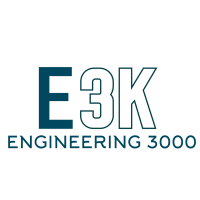3D Printing Design Services Company
3D printing has been a game changer in the manufacturing and engineering world in recent years. Its impact can be seen in the reduced costs, increased efficiency, and improved designs across various industries such as aerospace, automotive, and medical.
Aside from its benefits in industries, 3D printing also offers practical solutions for everyday life. It allows for the printing of discontinued or hard-to-find parts, the creation of unique and useful gadgets, and the testing of design fit and comfort. With just a design, the possibilities are endless.
If you are looking for 3D printing companies in Brisbane that are also experts at product design E3K Engineering would love to talk to you about your product and give you a quote if we can help. Contact us for more info.
E3K 3D Printing Services
E3K is a 3D design services and 3D printing company in Brisbane. We offer a 3D printing service and a 3D rapid prototyping service
We provide Fused Deposition Modelling 3D printing, which is also called FDM 3D printing. This type of 3D printing is the most common in the world. It consists of layering extruded molten plastic into a 3-dimensional object. There is a range of materials and colours available.
- Creating 3D computer-generated concept models
- Design and 3D computer modelling of components and full assemblies (product or machine)
- Design for Rapid prototyping/3D printing
Rapid prototyping is the fast fabrication of a physical part, model or assembly (product) using 3D computer-aided design (CAD). The creation of the part, model or assembly using 3D printing. E3K are experts at using rapid prototyping for product design.
3D Printing Information
3D Printer
Professional Dual Extruder 3D Printer for Large Printing – Pro3 Plus by Raise3D

Agile Production Made Simple
A professional dual extruder 3D printer with user-friendly features for an easier 3D printing experience, and a large build volume making it well suited for large-scale production and multi-sized rapid prototyping.
Pro3 Plus has a build volume of 300x300x605mm.
3D Print Key Performance

Flatness and Smoothness
- Consistent extrusion flow
- High degree move repeatability
- Print each layer right
- Reliable flatness and smoothness

Overhang Structure
- Optimized cooling airflow path and speed
- Deliver unflawed overhang structure
- Ensure smooth overhang surface

Geometry Accuracy
- Consistent quality for all geometry
- Precise linear motion in all dimensions
- Reliable conformance quality
3D Printing Materials
Choice of material with pros and cons and recommendations!
Pros: Keeps dimensional accuracy, gives great details, physically hard and cheap.
Cons:Brittle and low glass temperature (Will soften in a hot car on a summers day).
Recommendations: PLA is recommended for prints that don’t need much operational strength and best suited to figurines, static parts, models, art etc… However, PLA parts with higher infill density can sustain larger/operational forces very well.
Softening Temperature: 60-65 °C
Color: White/Black/Red/Yellow/Orange/Blue/Grey
Pros: Ductile, strong, long life, low price, higher glass temperature
Cons: Lower dimensional accuracy, UV light can make parts brittle over time (Generally years)
Recommendations: ABS is recommended for parts that need some level of operational strength or wear resistance is required from the part over high detail. It’s best suited for functional parts, prints exposed to ‘the elements’, hotter environments etc…
Softening Temperature: ~105°C
Color: White/Black/Grey
Pros: Ductile, strong, long life, low price, higher glass temperature, UV Resistant
Cons: Lower dimensional accuracy
Recommendations: ASA is very similar to ABS which is recommended for parts that need some level of operational strength or wear resistance with the addition of UV resistance. This makes it more suitable for outdoor applications where the print will be exposed to the sun for long periods. It’s best suited for functional parts, prints exposed to the sun, rain, wind and hotter environments
Softening Temperature: ~105°C
Color: Black
Pros: Durable, strong, impact resistance, chemical resistant, moderate price, flexible use
Cons: UV light can weaken the material over time (Generally years)
Recommendations: PETG is recommended for parts that need durability, flexibility, strength and impact resistance. This material is best suited to cases where the prints may undergo sudden stress or durability is necessary like for mechanical parts, cases, protective gear etc…
Softening Temperature: 85-95°C
Color: Black/Blue/Red/White
Pros: Extremely high strength, stiff, high temperature resistance, high chemical resistance, extremely hard to deform
Cons: Expensive, longer lead times, does not ‘bounce back’ after damaging impact or strain
Recommendations: This is the strongest material we currently print in! Polycarbonate is recommended for prints that need absolute strength, durability and stiffness, thus recommended for parts undergoing extreme impact or sustained forces other materials can’t withstand without deforming or breaking. Examples: Heavy use, structural parts, load bearing parts, tools, robots etc…
Softening Temperature: 150°C
Color: Black/White/Transparent
Pros: Extremely high durability, ‘flexible’, high-temperature resistance, high chemical resistance, tough, ‘bounces back’ after damaging impact or strain, low friction coefficient.
Cons: Expensive, longer lead times, softer than polycarbonate (scratches/mar’s easily)
Recommendations: Nylon is recommended for prints that require high durability, reliability and yield before breaking is ideal. This makes it good for mechanical parts like gears, sliders, hinges, wheels etc… where there is a lot of wear and tear but the part remains operational.
Softening Temperature: 70°C
Color: Black
Pros: Combined with Nylon, Extremely high durability and toughness, wear resistance, high temperature and flame resistance, high chemical resistance, ‘bounces back’ after damaging impact or strain,
Cons: Expensive, longer lead times, scratches due to matte finish, more rigid than Nylon due to Carbon Fibres (but increased properties above)
Recommendations: Nylon is recommended for prints that require high durability, reliability and yield before breaking is ideal. This makes it good for mechanical parts like gears, sliders, hinges, wheels etc… where there is a lot of wear and tear but the part remains operational.
Softening Temperature: 70°C
Color: Black








